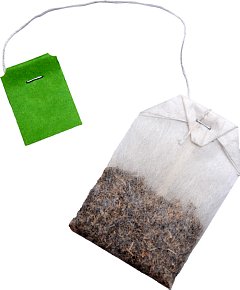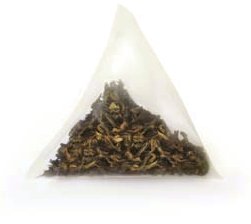History of the tea bag
Most modern commercially available tea bags containing CTC tea are made of bleached paper fibres and contain heat-sealable plastic. However, the very first tea bags were made of hand-stitched silk and contained the tea in whole leaves.
Discovered by accident
In the first decade of the 1900s, New York tea merchant Thomas Sullivan began sending small samples of his whole-leaf teas, packed in hand-sewn silk bags, to tea shops around the world.
Shipping the samples in silk bags was a cost-effective way for Mr Sullivan to get his new teas into customers’ cups without the expense of packing and shipping them in tea boxes.
The whole leaf tea would have had to be removed from the silk bag for brewing, but customers found it easier to brew the tea in the bag. So when the customers ordered tea from Mr Sullivan again, they asked him to send them the tea in bags.
Evolved over time
As hand-stitched silk tea bags proved to be expensive and time-consuming to make, Mr Sullivan switched to gauze and by the 1920s was making commercial tea bags for his customers.
Since Mr Sullivan did not patent his discovery of the teabag, other traders began to market their own versions of the teabag – very cleverly patenting their own inventions – and over time different versions of the teabag evolved.
- It is believed that German tea manufacturer Teekanne have developed its own version of the teabag for soldiers during the First World War. The bags, known as ‘teabombs’, were made of fine cotton and were part of every German soldier’s kit.
- William Hermanson, the founder of a Boston paper company, patented the first heat-sealable tea bag made from paper fibres in 1930.
- In 1944, the Tetley Tea company, invented the first square tea bag in England. Inspired by the invention of the tea bag by the Americans, they developed a tea filter machine that could sew 40 tea filters per minute for export.
- The Lipton Tea Company, founded in Scotland in 1880, patented the four-sided, free-flowing paper tea filter in 1952. The two-compartment bag allowed the tea to come into better contact with the water and the tea leaves had more room to expand inside the bag.
- Tetley Tea was the first company to introduce the round paper tea filter in 1992. This was mainly a marketing invention for tea drinkers who preferred to drink tea from a large cup rather than a delicate cup. Another great benefit that the round paper filter brought was that it also reduced packaging waste, as round tea bags usually do not come with the paper string and label of square tea bags.
- The pyramid-shaped tea filter was invented in the UK in 1997 by Brooke Bond, the parent company of PG Tips. According to them, the pyramid shape acts like a teapot, and tea leaves have 50% more space in the bag than in flat bags, allowing them to expand and produce better quality teas.



